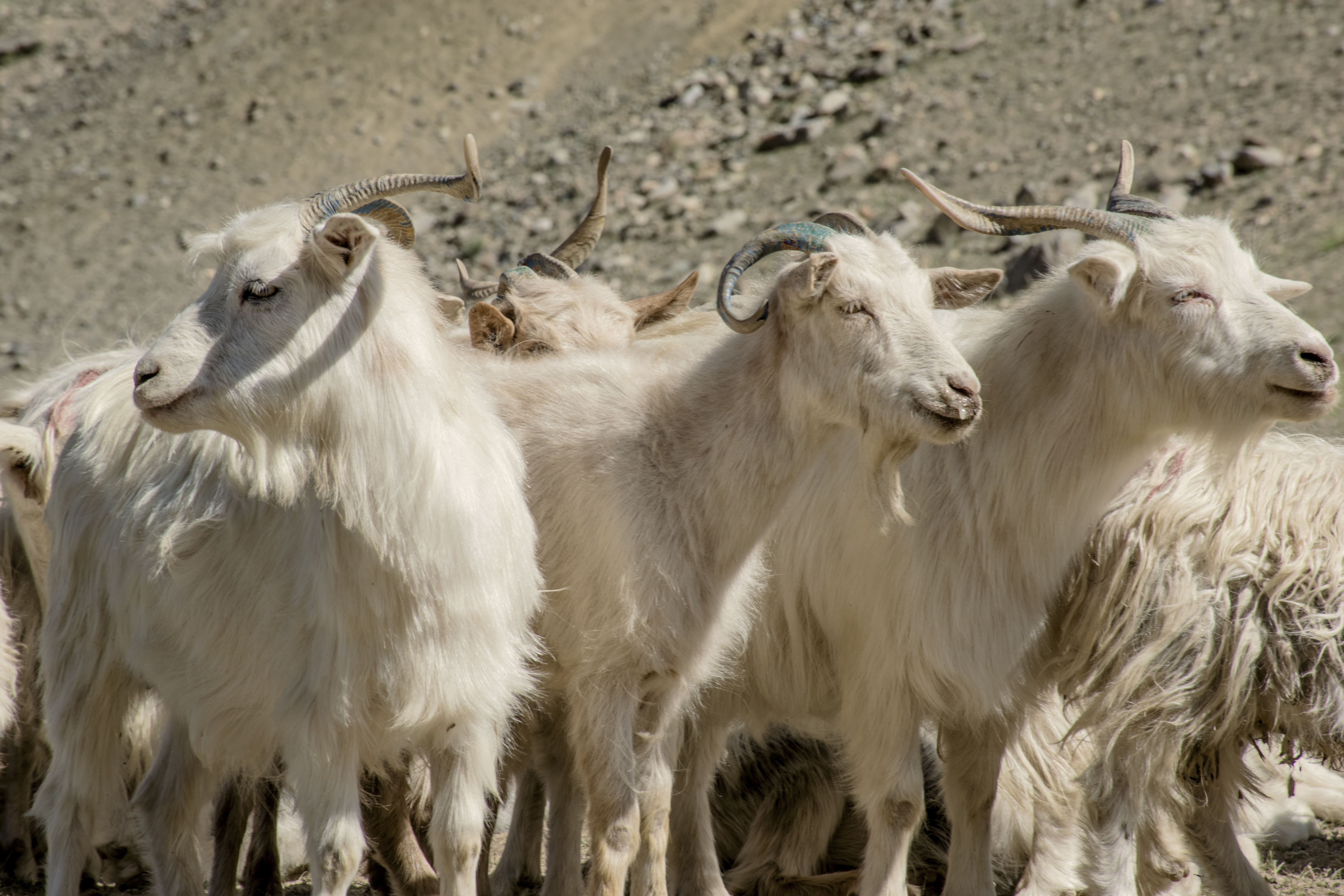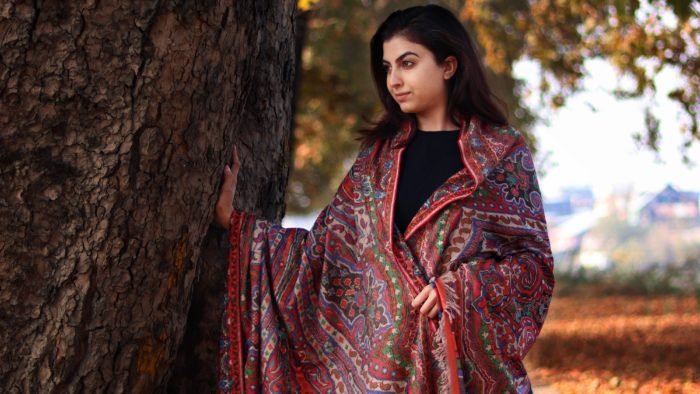Aaditya (Adi) Kitroo is a man possessed, for he dreamt of settling down in Srinagar at a time of militancy, curfews, displacement and uncertainties. His joint venture Jos & Fine with Safia Igranaissi of France is the story of the acclaimed but highly at risk Pashmina from Kashmir.
In addition to sheer beauty of the fabric itself and the allure of the Ladakh terrain, is a centuries old legacy of weaving pashm into a Pashmina, the Pashmina that had crossed the Hindukush in 16th century and was the toast of European society in the 18th century. It epitomised ultra-luxury, its intricate weave and subtle mellow sufiana colour palette had defined fine aesthetic sensibility so much so that these pieces became collectibles.
Adi wanted to reclaim the textile which was being marketed by Italians and Scots under the generic name Cashmere, with no geographic moorings to the Valley which had nurtured it.
Says Adi in his website: “Throughout the 20th century, the only luxury fabric to be named after its place of origin, slowly started to lose its identity due to increasing industrialization. From the mass breeding of Cashmere goats in northern China and Mongolia, to the excessive number of mills and processing centres across the globe, the commercialization of Cashmere caused the fashion world to slowly lose track of the original shawl that had been stealing the hearts of ladies over the centuries. The real Cashmere shawl, crafted from the very finest and rarest strain of Himalayan Cashmere, and processed from raw fibre into the most exotic and softest woollen fabric known to mankind, once the subject of novels, was no more.”


Aaditya and Safia
In a long chat with CSP, a very articulate Adi spoke about the culture of pashmina, its history and grandeur, his motivations for diving into the world of textiles; the trials and challenges and the future of pashmina with Jos & Fine.
It was while pursuing his MBA at the Rotterdam School of Management in the Netherlands, while walking in P.C Hoofstraat – Amsterdam’s luxury shopping street and visiting a few luxury boutiques, that Adi had an epiphany. “It was around Christmas time and everyone wanted to buy a Cashmere product, but none of it was made in Kashmir.”
He couldn’t help but notice the difference between the handcrafted Pashmina scarf he was wearing and the Italian and Scottish Cashmere scarves available in the market at exorbitant prices. Being from the Valley, he knew his Pashmina. He knew the Pashmina sold was no match to the authentic pashmina woven out of pashm from Changthangi goats that roamed the most difficult terrain in the world. Their underside wool is less than 13 microns in diameter and this gave the Pashmina its warmth and allure.

The memories of his childhood years spent at his grandfather’s home in Srinagar, the warmth of shawls worn by his mother, aunts and cousins, and his father's textiles export would draw him into the world of the shawl.
Analysing the reasons for the fall of Kashmir’s legendary hand-spun hand-woven Pashmina Adi says “Paucity of quality control, modern branding, international design, and a disorganised production chain.” At the time he entered into the field, neither the wool nor the fabric from Kashmir was recognised in the international market. In such a scenario it looked daunting to retail pashmina from Kashmir.
Adi quit his job with Tata Consultancy Services and joined his father’s textile trade as a first step and then he enrolled for his MBA. While working with a European organic food company he organised a sale and exhibition of the Pashmina from Kashmir. The tremendous response was the assurance he needed. He had tremendous confidence that he could showcase the best Pashmina for two reasons; the finest wool came from Ladakh and the finest weavers resided in the valley.
He enrolled at Erasmus University’s ‘Get Started’, the academic incubator for many of the successful start-ups of Europe. It was here that he met Safia when he put out an application for a co-founder. “Safia seemed to be the most interesting applicant because she had worked in the luxury home textiles industry in Belgium and France. We clicked immediately.” After spending three months at the start up they decided to work together.
They founded Jos & Fine, a word play on the French queen Josephine a great patron and collector of Pashmina. The tagline of the partnership was “Our soul is French while our heart lies in Kashmir.”
They decided that Aditya would manage the manufacturing side of the business from Kashmir and Safia would handle the marketing and designs, based in France.
Adi returned to Srinagar end of August 2015, a period of great distress and turmoil in the Valley. What scared him most was not finding any weavers and the end of a legacy. When one local told him: “Panditji yeh sab khatm hoh jayega (all this will die away soon), he was determined to take his chance against the bullets that had become a part of everyday Kashmiri life.
Of those initial days he says: “It was a struggle at the start. I had three things to do: start a business from scratch, renovate the house which had been damaged quite a bit from floods in September 2014 and of course immerse myself into the Kashmiri way of life as my Kashmiri roots had become rusty and Kashmiri society was understandingly a bit sceptical in the beginning.” He persevered, learned the language, studied the craft and embarked on serious R& D.
He dug out old research reports on Pashmina wool, read and compared the wool from different stations and zeroed on a station that had reared Pashmina goats that gave the wool with the smallest diameter - 12.5microns. He realised that while all Pashmina is Cashmere but all Cashmere is not Pashmina. Pashmina had to be hand crafted from wool with a lesser diameter.

The next stage was to get the best spinners to spin the wool. Their team met the women who were traditional yarn spinners and identified those who were able to spin the wool into the thinnest yarn with their charkhas. Once that was done, they found the skilled weavers to weave the best fabric.

This wool was cleaned, hand spun, woven, dyed all with hand. Reliving the memory he says, “We created this fabric using age old processes, not a single watt of electricity was used at any stage. Because it was handmade and because we had used redundant age-old practices the fabric that came out was much finer. There was a human element to it and it was better than the Pashmina that was produced by state-of-art spinning mills in Italy. In 2017, the Craft Development Institute established by the Union Ministry of Textiles, ratified Jos & Fine's product to be the finest Pashmina fabric ever tested.
The woven magic was received with wondrous surprise and their first client was an exclusive store in Napa Valley. In the first year itself they made a profit and started retailing in France and stores across Europe.
In 2017, the Craft Development Institute established by the Union Ministry of Textiles, ratified Jos & Fine's product to be the finest Pashmina fabric ever tested.
They had to decide soon whether to concentrate on weaving Pashmina fabrics, stoles, scarves, blankets customised for European markets with subtle contemporary designs or to carve out a niche for Jos & Fine?
The only way to make Jos & Fine Pashmina aspirational was either by introducing design innovations or by weaving the most the gorgeous Pashmina in intricate designs, with its very exquisiteness defining it as a work of art - a museum piece. In Europe, Pashmina had not been only a fad but also considered an art investment. So why not revive those Pashminas of yore, the Kani Pashmina?
“The idea came about two years ago to recreate Kani shawls with levels of detailing and finishing that went extinct around a century ago. The idea was in line with our company’s motto “Scripted in France, Crafted in Kashmir” for the French were the main patrons of Kani shawls in the 1800s with French merchants and designers regularly travelling to Kashmir those days to customise patterns designed by Berrus,” says Adi.
Project Legacy became a tribute to Berrus, the French designer who had designed shawls for European clients and which were woven by the Kashmiri craftsmen in the 18th century. Adi’s project had come full circle, when the Valley once again started recreating those glorious days of Kashmiri Pashmina.

“The intention behind Project Legacy was to revive the lost art of weaving intricate Kani shawls and embroider museum grade pieces, to put the customer in the centre of creating such a masterpiece and finally to give dignity to lives of the unsung nameless karigars of Kani shawls.”
Adi says the masterpiece is designed uniquely for the client and meticulously hand-crafted with an array of customisations offered. Pieces are commissioned based on two samples sent to the client in two different colour combinations. Then follows a series of exchanges on design elements, colour combinations after which the work starts. It takes about seven months to complete a personalised Kani Pashmina and upto 24 months for a silk embroidered Sozni Jamawar.
Adi says the main patrons are connoisseurs of Pashmina and collectors from different parts of India who also look at these pieces as investments that increase in value over time. “Outside India, it gets quite interesting for we have European and American clients who are looking to create true bespoke pieces, usually very large Kani shawls, which can then be used as wall hangings. I believe that once a very high level of craftsmanship is achieved the applicability of the piece does not remain just that of a wearable item but also as an art piece that can be framed and displayed.”
At present, Project Legacy Kani pieces are limited to only 10 pieces per year of which half are already booked before the crafting process has begun. The embroidery pieces are limited to 24 pieces a year. Soon, he says, there will be a waiting list of clients.

He has studied museum pieces in London, Paris, Amsterdam, Thailand, Delhi, and Srinagar. Design lies at the heart of the Kani. Being a purist he has remained true to its pattern, the motifs which remind one of Kashmir - the spring season, the gardens, the bootis, the geometric patterns, chinar leaves, some designs that came from Persia but also “designs inspired from Kani shawls designed in the 1800s by French designers especially Berrus and were recreated with motifs that were more modern and in line with the choices of customers today.”

Berrus’s designs were customised by artisans in the Valley three centuries ago in the absence of internet and mobile networks. And yet, it was a thriving industry because there were many skilled weavers and embroiders unlike today when he had to travel beyond Srinagar and its suburbs in search of artisans for Project Legacy.
The Kani shawl is truly unique. “It is about pushing the limits of craftsmanship to create pieces that are truly masterpiece. I do not consider a Kani Jamawar to be a masterpiece unless the levels of detailing and finishing in it are such that people rarely see. Under Project Legacy, we more than doubled intricacy from around 130-150 tujis of the Kani Jamwar made these days to around 350-400 tujis per meter in the weft which allows us to craft such pieces. Of course, the main challenge here is scalability as training artisans to such levels takes time.”
Adi has started a project for training new artisans. Project Legacy has brought dignity to the lives of the weavers. It pays them handsome wages and has discovered two women weavers whose weaving is so fine that they are called “Sheroes!”
He has been living in Srinagar since 2016. He has faced disruptions and delays, but the work has never stopped. Even during the worst of times, he has worked around curfews and bandhs. During times when curfew was imposed, he would visit the homes of the artisans early morning and be home before the curfew commenced.
When Article 370 was revoked last year, he had shifted to Jammu to access the internet to keep business running and to be in touch with clients. He would send instructions to the team in Srinagar with cab drivers from Jammu. During Bakrid, Aditya made sure the karigars were not without money to celebrate the festival.
In recognition of his efforts he was awarded the 'Champion of Change 2017’ by the Prime Minister for navigating through a complex maze and establishing a system wherein the Pashmina of centuries gone by is re-created and brought to customers around the globe.
Revival of the Kani Pashmina is a tribute to the resilience of human nature, of the nameless karigars for whom weaving is sacred. Jos & Fine recognises their veneration for their craft by asking them to embroider their names on the pieces thus recognising them as creators of Masterpieces. Signed off in style.
 Ghulam Hasan's masterpiece
Ghulam Hasan's masterpiece
(Photos Courtesy Aaditya Kitroo, Jos & Fine website)





